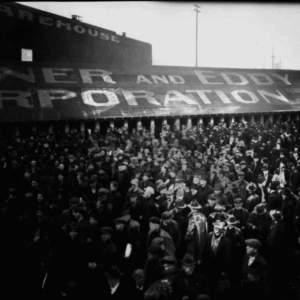Radical Seattle:
The General Strike of 1919
290 pages; $26.00 pbk; ISBN 9781583678541
By Cal Winslow
Reviewed by Liam Ó Discín for Socialist History
In 1919, in the midst of the Spanish flu pandemic, during a period of great worldwide turmoil, workers in Seattle shut down their city and ran it for five days. In Radical Seattle: The General Strike of 1919, Cal Winslow depicts this extraordinary event which began as a campaign of solidar.ity for the city’s dockyard workers and represented the high point in a longer process of socialist and working-class organisation in the Pacific Northwest.
However, Radical Seattle is not just about the five days of the strike. Winslow argues that it is only through examining the background, the intense bitter conflicts, the discontent of the working people, and the socio-economic structure that workers found themselves in, can we ask ourselves: What was it that made Seattle ‘a city where workers could imagine themselves running industry’?
The opening three chapters take on a thematic and contextual approach. Seattle was both a boom town and a centre for radical politics. The city had two enormous attractions for capitalists due to its harbour and the abundant resources of timber in Washington State. Huge sawmills and lumber camps invaded vast forests. Working life in the camps was both precarious and dangerous the mill owners were rabidly anti-union.
Conversely Seattle and Washington State had a history of anti-establishment beliefs going back as far as The Populist Party, to the cooperative movement, the Socialist Party to the Industrial Workers of the World (IWW). Seattle was a beacon for socialists of various persuasions. The city’s branch of the American Federation of Labor (AFL) was against America’s entry into World War I, had pressed for recognition of the fledgling Soviet Union, and Seattle dockworkers refused to handle weapons destined for Alexander Kolchak’s White Army. The Seattle labour movement had also supported calls for a general strike during the campaign to free Tom Mooney and Warren Billings, two labour activists who had been falsely accused of the Preparedness Day bombing of 1916 in San Francisco….
While the shipyard workers campaign largely concerned ‘bread-and-butter’ trade union issues, the call for a sympathy strike resonated across the city. It represented a tension within the labour movement between that of the narrow craft unionism of the national organisation of the AFL, and broader industrial unionism of the IWW, which believed in a ‘One Big Union’ transcending occupational lines.
As previously noted, things were different in Seattle. While there were radicals throughout the US they tended to be on the fringes, in Seattle there was a more inclusive ‘radical consensus’. Members of the AFL, the IWW, and socialists shared platforms and openly fraternised together. This ‘intense localism’ as historian Robert Friedheim called it, is what made Seattle unique. On 6 February 1919, Seattle’s workers – all of them – struck. The general strike was called by Seattle’s Central Labor Council (CLC), headed by James Duncan, a Sunday school teacher. It represented 110 unions, all affiliated with the AFL. Tens of thousands participated in the strike in support of 45,000 shipyard workers in Seattle and nearby Tacoma. Laundry workers, hotel maids, miners, and even musicians all took part in the strike. For five days in February, workers ran Seattle.
It is noteworthy that the shutdown of Seattle’s economy did not trigger a social unravelling or lead to wanton violence. The leaders of the strike also maintained vital services. Refuse continued to be collected, milk runs and ‘strike kitchens’ were opened, public safety patrols were organised, while the fire service and other critical services, such as telephones and the electricity supply, were also maintained. The General Strike even managed to penetrate the city’s racial divide as Japanese immigrant workers embraced the strike. The Japanese Labor Association donated $50 towards the strike. Its leader, Katsunari Sasaki, wrote to James Duncan appreciating the fact that ‘some local unions of organized labor here in Seattle have had a good feeling toward us while American Federation of Labor is still discriminating us and refusing to become member of organization’. Women also played a crucial role both before and during the strike. Many female workers within the hotel maids and laundry workers unions, mobilised and volunteered along with their male counterparts. Iconic labour heroines, such as Elizabeth Gurley Flynn, Anna Louise Strong, and Kate Sadler, all receive deserved recognition throughout this work.
But why did it all end after only five days? The strike ended primarily because it became isolated. It didn’t spread down the coast to California, nor was there widespread support from the country for it. So, this time it wasn’t because of a violent crackdown or due to internal struggles – the way that most strikes are defeated. Aside from the traditional foes of organised labour, a high proportion of blame can be left at the door of the national organisation of the AFL. Its president, Samuel Gompers, boasted that the ‘insubordination of the general strike’ was ‘destined to die an early death’ and that it was the AFL and not the US State Troops ‘which ended this brief industrial disturbance of the Northwest’.
While the five days of February were peaceful, the inevitable violent crackdown on radicals and organised labour followed. One such particularly gruesome spectacle occurred in Centralia. There Wesley Everest, an ex-serviceman, was caught by members of the American Legion after an attack on the local IWW hall. After Everest’s capture, he had his teeth knocked out and was dragged through the town to the local jail with a belt around his neck. Later that night a group of men forced their way into the jail and castrated him in the back of a car. He was then dragged to a bridge where he was hung twice. After being shot at, the body was then taken down and displayed in front of prisoners to make a clear point.
So, what are we to make of the Seattle General Strike of 1919? Winslow’s work is an attempt to debunk the narrative of the strike as merely a failure, but rather afford it its due recognition as ‘the highest point in a longer process of socialist and working-class organisation’. There are those on the left who point out the naivety of not thinking about how the general strike might lead to the gaining of political power. Yet despite being inspired by the events of the revolution in Russia, a decade of struggle and activism in the log camps and timber mills, a history of non-conformity, a proud localised ‘radical consensus’, its fundamental purpose wasn’t all that explicitly revolutionary. The strike meant different things to different people. As Winslow shrewdly surmises: ‘Some were striking to gain a definitive wage increase for their brother workers in the shipyards.’ A minority undoubtedly were striking because they thought ‘The Revolution’ was about to arrive but for many, it was essentially a show of solidarity. While many valid criticisms may be made regarding the failed tactics or shortcomings of the strike; most of these are based on the gift of hindsight.
The aim of this work was not just to describe the events of 6-11 February 1919 but also ‘an attempt to recover the decade-long making of the collective capable of launching one of America’s most gripping strikes’. Cal Winslow more than succeeds in this objective. Radical Seattle is a powerful read.
To read the full review go to Socialist History (61.indd 96)


Comments are closed.